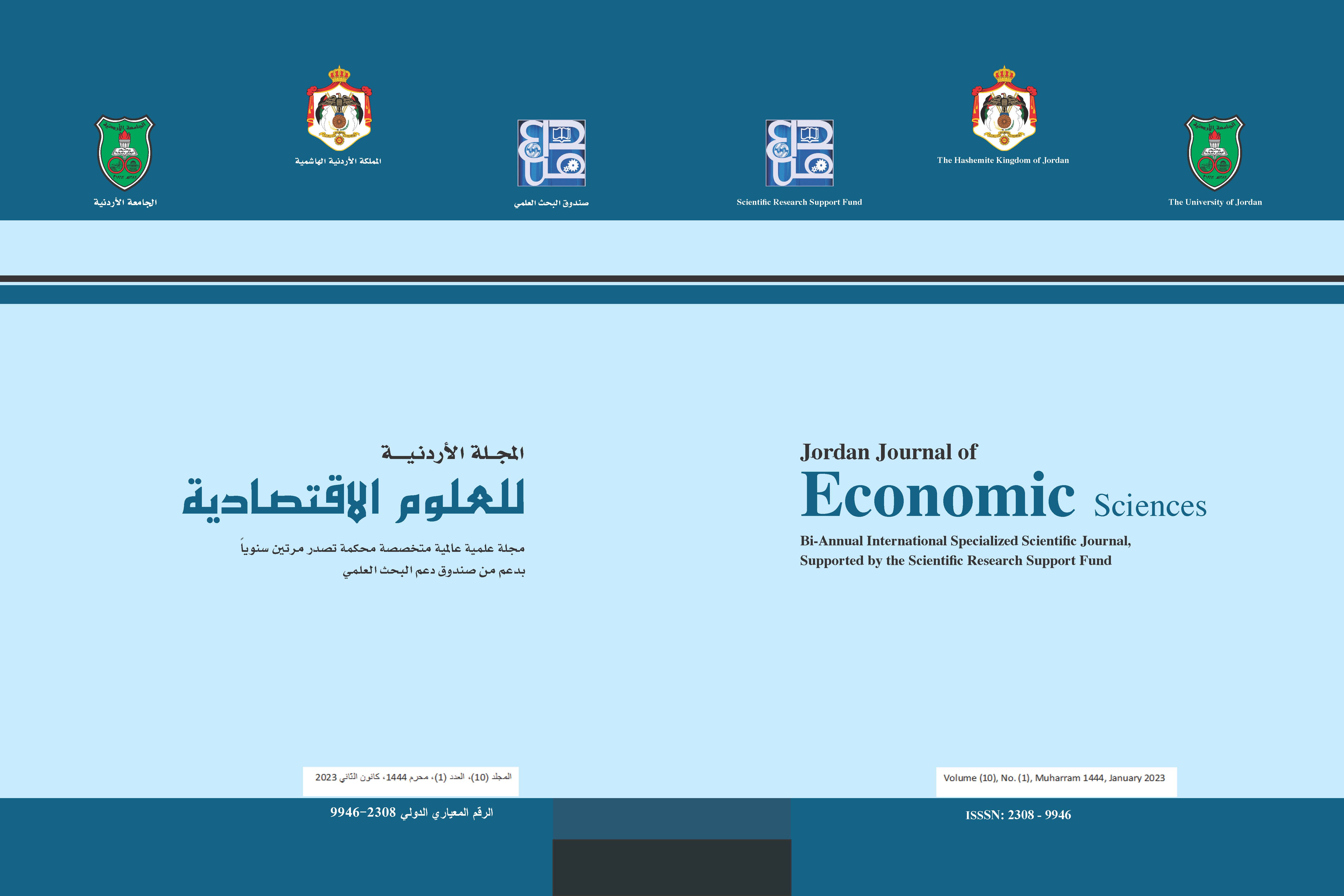The Impact of Fiscal Policy Tools on Unemployment Rates in Jordan: Autoregressive Distributed Lag Approach
DOI:
https://doi.org/10.35516/jjes.v10i1.843Keywords:
Unemployment, Fiscal policy, Government expenditure, Tax revenuesAbstract
Objectives: The main objective of this study is to investigate the impact of fiscal policy tools on unemployment rates in Jordan during the period 1986-2019.
Methods: The study estimated two models; the first consists of tax revenues and aggregate government expenditure as independent variables, and the second consists of tax revenues in addition to capital and current government expenditures as explanatory variables.
Results: The study variables are integrated at different levels and cointegrated in both models as indicated by Augmented Dickey-Fuller Unit Root Test and Bounds Cointegration test. Therefore, the study used the Autoregressive Distributed Lag approach for estimation. The results for the first model clarified that the increase in aggregate government expenditure causes unemployment rates to decline in the short and long run. On the other hand, the results for the second model showed that the increase in tax revenues increases unemployment rates in the short and long run. Moreover, current government spending has significant negative short and long-run effects on unemployment rates, while capital spending has only a significant negative short-run impact.
Conclusions: Based on these outcomes, the study has introduced some recommendations with regard to increasing the effectiveness of fiscal policy instruments in reducing unemployment rates in Jordan.
References
Abouelfarag, Hanan. and Qutb, Rasha (2021), Does Government Expenditure Reduce Unemployment in Egypt? Journal of Economic and Administrative Sciences, 37(3): 355-374.
Adeinat, Mohammad. (2020), A Reading of the History and Current State of the Jordanian Economy, Amman, Jordan: Dar Wael for Publishing and Distribution.
Alrawashdeh, Amani, Al-Tarawneh, Alaa Aldeen and Shawaqfeh, Waleed (2019), The Impact of External Aid on Public Capital and Current Expenditures in Jordan (1979-2015), Jordan Journal of Economic Sciences, 6(1): 23-40.
AL- Saraireh, Shadi (2014), The Relationship between Unemployment Rate in Jordan with Rates of Foreign Labor Force, Government Expenditure, and Economic Growth, International Journal of Business and Social Science, 5(3): 294-301.
AlSebti, Latifa (2019), The Impact of Real Economic Growth on the Unemployment Rate (Okun’s law) in Algeria an Econometric Study for the Period (1990-2016), Jordan Journal of Economic Sciences, 6(2): 199-210.
Barro, Robert J. (1990), Government Spending in a Simple Model of Endogenous Growth, Journal of Political Economy, 98(5): 103-126.
Barro, Robert J. and Sala-i-Martin, Xavier (1992), Public Finance in Models of Economic Growth, The Review of Economic Studies, 59(4): 645-661.
Borensztein, Eduardo., De Gregorio, Jose. and Lee, Jong-Wha (1998), How Does Foreign Direct Investment Affect Economic Growth? Journal of International Economics, 45(1): 115-135.
Central Bank of Jordan, Annual Reports, Annual Report 2008, Amman, Jordan.
Colombier, Carsten (2009), Growth Effects of Fiscal Policies: An Application of Robust Modified M-Estimator, Applied Economics, 41(7): 899-912.
Department of Statistics, Jordan in Figures 2008. Amman, Jordan.
Dickey, David A. and Fuller, Wayne A. (1979), Distribution of the Estimators for Autoregressive Time Series with a Unit Root, Journal of the American Statistical Association, 74(366): 427-431.
Fosu, Grace Ayiwah (2019), Government Expenditure and Unemployment: Empirical Investigation of Sub-Saharan African (SSA) Countries, Masters theses 4573. https://thekeep.eiu.edu/theses/4573
Granger, Clive William (1969), Investigating Causal Relations by Econometric Models and Cross-spectral Methods, Econometrica, 37(3): 424-438.
Mishal, Zakia Ahmad (2019), Macroeconomic Effects of IMF Stabilization Programs: Evidence from Jordan, Jordan Journal of Economic Sciences, 6(1): 1-22.
Monacelli, Tommaso, Perotti, Roberto and Trigari, Antonella (2010), Unemployment Fiscal Multipliers, Journal of Monetary Economics, 57(5): 531- 553.
Mugableh, Mohamed (2019), Fiscal Policy Tools and Economic Growth in Jordan: Evidence from Time-Series Models, International Journal of Economics and Finance, 11(1): 1-7.
Obayori, Joseph (2016), Fiscal Policy and Unemployment in Nigeria, The International Journal of Social Sciences and Humanities Invention, 3(2): 1887-1891.
Omran, Emad and Bilan, Yuriy (2020), The Impact of Fiscal Policy on the Unemployment Rate in Egypt, Montenegrin Journal of Economics, 16(4): 199-209.
Pesaran, M. Hashem and Shin, Yongcheol (1998), An Autoregressive Distributed-Lag Modelling Approach to Cointegration Analysis, Econometric Society Monographs, 31: 371-413.
Romer, Paul M. (1986), Increasing Returns and Long-Run Growth, Journal of Political Economy, 94(5): 1002-1037.
Saraireh, Shadi (2020), The Impact of Government Expenditures on Unemployment: A Case Study of Jordan, Asian Journal of Economic Modelling, 8(3): 189-203.
Tagkalakis, Athanasios O. (2013), The Unemployment Effects of Fiscal Policy: Recent Evidence from Greece, IZA Journal of European Labor Studies, 2:11. https://doi.org/10.1186/2193-9012-2-11
Umut, Unal (2015), The Unemployment Effects of Fiscal Policy in Netherlands, MPRA paper 81433, University Library of Munich, Germany.
Zirgulis, Aras and Šarapovas, Tadas (2017), Impact of Corporate Taxation on Unemployment, Journal of Business Economics and Management, 18(3): 412-426.



